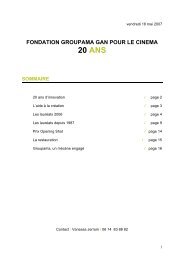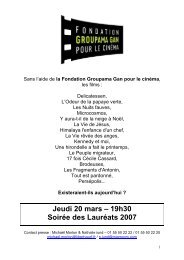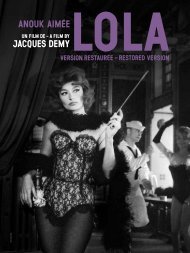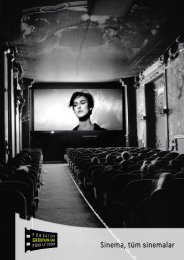duVoyage - Fondation Groupama Gan pour le Cinéma
duVoyage - Fondation Groupama Gan pour le Cinéma
duVoyage - Fondation Groupama Gan pour le Cinéma
Create successful ePaper yourself
Turn your PDF publications into a flip-book with our unique Google optimized e-Paper software.
offices. Films were melted down in order to extract silver, and ironically, to be converted into celluloid. In 1920,<br />
Méliès gave his last performance at the Robert-Houdin theatre. The theatre was <strong>le</strong>t afterwards, first by theatre<br />
companies, then became a cinema until 1923, after which the building was demolished as part of works on<br />
bou<strong>le</strong>vard Haussmann. Méliès had run this mythical place for 35 years. The film copies preserved in the theatre<br />
were sold by the kilogram to a resel<strong>le</strong>r specialised in B films for amateurs.<br />
1923 was a terrib<strong>le</strong> year for Méliès. He was forced to sell his Montreuil property. In a moment of anger, Méliès<br />
burned his who<strong>le</strong> stock of negatives in the garden of Montreuil.<br />
In 1925, Méliès married Jehanne d’Alcy. She too had lived through difficult times, but had managed to buy a small<br />
shop at Montparnasse station. Together they ran the small kiosk, selling sweets and toys to passing travel<strong>le</strong>rs.<br />
Late recognition<br />
René Clair and Paul Gilson played a major ro<strong>le</strong> in highligthing Méliès ro<strong>le</strong> in cinema and his work: they published<br />
an artic<strong>le</strong> on him in the Revue du <strong>Cinéma</strong> in 1929, and launched the idea of holding a gala retrospective<br />
of his work in the same year.<br />
After a first viewing in Studio 28, a studio specialising in the avant-garde, the Méliès Gala was held in the<br />
P<strong>le</strong>yel Hall in Paris on 16 th December 1929. The few films by Méliès were accompanied by Forfeiture (1915) by<br />
Cecil B. De Mil<strong>le</strong>. In paral<strong>le</strong>l, Méliès donated the automated machinery from the Robert-Houdin to the Arts et<br />
Métiers Museum in Paris, which unfortunately later resold or destroyed the price<strong>le</strong>ss 19 th century theatrical machines.<br />
In 1932, Méliès was ab<strong>le</strong> to <strong>le</strong>ave Montparnasse station. A mutual aid association created by former cinema artists<br />
had just acquired offices near Orly airport. Méliès, his wife and his grand-daughter Made<strong>le</strong>ine, were ab<strong>le</strong><br />
to move into a three-room apartment, where he lived until his death. He died three months after being diagnosed<br />
with cancer, on 21 January 1938 at the Léopold Bellan hospital in Paris, and was buried at the Père-Lachaise<br />
cemetery on 25 January. His funeral was attended by René Clair, Henri Chomette, Nadia Sibirskaia,<br />
Ferdinand Zecca, Alberto Cavalcanti and Louis Aubert, among others. On his gravestone: “Méliès, creator of<br />
the cinematographic show, 1861-1938.”<br />
92<br />
1896-1913:<br />
Georges Méliès<br />
and the cinema industry<br />
After 1895, the pre-cinema era - symbolised by the Kinescope that allowed individuals<br />
to see moving pictures through a viewing slot – was definitively over.<br />
The Lumière brothers’ projector, officially presented to the public on 28 December<br />
1895, now enab<strong>le</strong>d on-screen projections to an audience.<br />
1895-1900:<br />
Cinema invents<br />
During this period, neither artists nor the viewing public were what cinema was all about.<br />
The era was essentially characterised by invention.<br />
The films proposed were short (around one-minute long) and the subject matter was unimportant:<br />
a train entering a station would do... Artists were not behind the camera : an operator<br />
filmed subject matter that was relatively poor and lacked narrative structure. What<br />
peop<strong>le</strong> wanted to see were moving pictures.<br />
Films were sold (the idea of film rental would come later), mainly to fairgrounds, which incorporated<br />
them into existing shows. Projection conditions were extremely poor (damaged<br />
film, bad lighting...). The public wanted to see the technical invention that was just one of<br />
the attractions on show at the fair (magic shows, popular music, clowns, monsters, etc...).<br />
And when in April 1896, Georges Méliès decided to project films in his own theatre, he broke<br />
with tradition, turning the Robert-Houdin theatre into one of the first cinemas. He had<br />
changed the programme radically: theatre performances were dedicated exclusively to cinematography,<br />
magic performances took place in the morning only, on Sundays and Thursdays.<br />
The change did not last long, however: after 8-10 weeks, the public deserted him.<br />
Georges Méliès had to revert back to a more traditional theatre schedu<strong>le</strong>, and he continued<br />
to sell to fairgrounds, the main distribution channel for his films.<br />
The Universal Exhibition of 1900:<br />
The Lumière brothers project onto a giant screen<br />
In 1900, the Universal Exhibition classed cinema as a technique: it was part of class III – Instruments<br />
and general literature, science and arts – and within class III it was categorised<br />
as a subset of Photography. It was seen as deriving from photography and as a reproduction<br />
technique, similar to printing.<br />
Only two peop<strong>le</strong> linked to cinema were members of the committee for this class: Ju<strong>le</strong>s-<br />
Etienne Marey and Louis Lumière. Méliès was not officially present at the Exhibition. Each<br />
country used cinematographic projection to present its contribution and work. Within this<br />
context, the cinema was not considered pure entertainment: it was used to support <strong>le</strong>arned<br />
presentations and demonstrations. Paradoxically, if cinema had yet to find its place, there<br />
was a willingness on the part of the General Commissariat of the Universal Exhibition to<br />
93

















